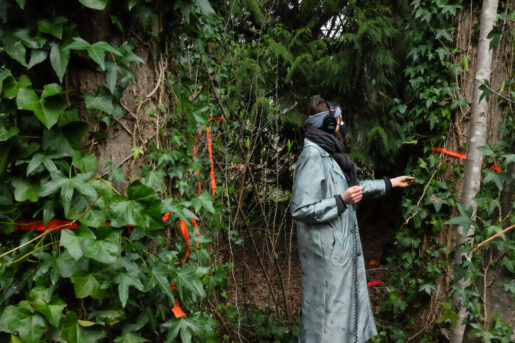Wild Empathy

Posted on | Updated
Investigating the use of VR technology to create empathy for old-growth trees.
BC is known for its wilderness and lush green forests. But logging, development and climate change have all caused dramatic changes to our landscape, threatening the future of our old-growth forests. ECU faculty member and researcher Julie Andreyev is working to raise awareness of the value and irreplaceability of these ancient trees through very modern technology.
Using immersive media, Julie and her research team are developing a VR prototype that will allow individuals to explore and interact with an old-growth tree to better understand and appreciate their importance. Her project, Wild Empathy, is grounded in recent research from Stanford University’s Virtual Human Interaction Lab, which found that people can develop empathy for plant and animal species through VR environments.
“The reason that we’re selecting an individual tree is we really want to tell a story about how these old trees are really critical to the biodiversity of the forests,” explains Julie. “We’re using using stereoscopic video, immersive video and animation approaches, and having a tree as the main character. Rather than using abstractions and larger concepts of communities, we’re really trying to create that real empathetic relationship between the participant and the tree.”
The Stanford research team found that VR interactions with trees led to increased empathy and corresponding ecological behaviours, such as decreased paper use. Julie’s project seeks to further this emerging knowledge area by investigating the generation of empathy with specific local forest systems.
The Stanford study also determined two critical conditions of an empathy-generating experience: it needs to be immersive, and involve one-on-one interaction with the species at risk. Creating an immersive, realistic environment requires specialized tools, including extremely sensitive microphones that can record the trickle of water movement beneath the bark of the tree and the movement of microorganisms in the soil below. Stereoscopic video tools will also be used to capture high-definition video of the forest environments. Funding for this equipment was provided by the Ian Gillespie School of Design + Dynamic Media Research Fund.
Julie’s interdisciplinary team includes Maria Lantin, Director of the Basically Good Media Lab, undergraduate research assistants Mana Hairichian Saei in the NMSA program and Animation student Edward Madojemu, and Sean Arden, research technician in the Mixed Reality Lab. External partners include UBC researcher Dierdre Brink, documentary filmmaker Damien Gillis, composer Simon Overstall, and computer scientist David Baar.
The team will travel to Vancouver Island, where they’ll survey a number of possible trees for the project in an intact old-growth forest. They’ll gather visual and sound material on-site, using the participation of the selected tree. The concept of a tree as an active participant may sound unusual, but it’s Julie’s area of practice, which focuses on interspecies creativity and communication, and co-creating experiences with non-human participants.
“There’s lots of life, lots of agency in these forests—things we as humans have often assumed just exist,” explains Julie. “In a cubic metre of healthy soil there’s hundreds of insects, billions of bacteria, all kinds of life happening: earthworms, other microbial life-forms. Because we work in visual and auditory fields, we can find ways to capture that kind of liveliness rather than synthetically producing it. For instance, the cells beneath the bark pull the water up the canopy and into the leaves, so we’d want to record that.
“So we’re looking for a specific tree where we could record that activity that the tree is producing, without harming the tree. Maybe there will be a little crack in the tree where we can insert a stethoscope and listen. We need to see what individual trees can offer, and then look at our video recordings, listen to our sound recordings, and decide how we can best represent the tree in a way that will capture its unique character.”
The team hopes to use their project as a learning and research tool for design and media students at Emily Carr. Julie also hopes the VR experience could be shared with schools around BC, as well as in gallery exhibitions, to build empathy for our unique forest ecosystems across the province.

